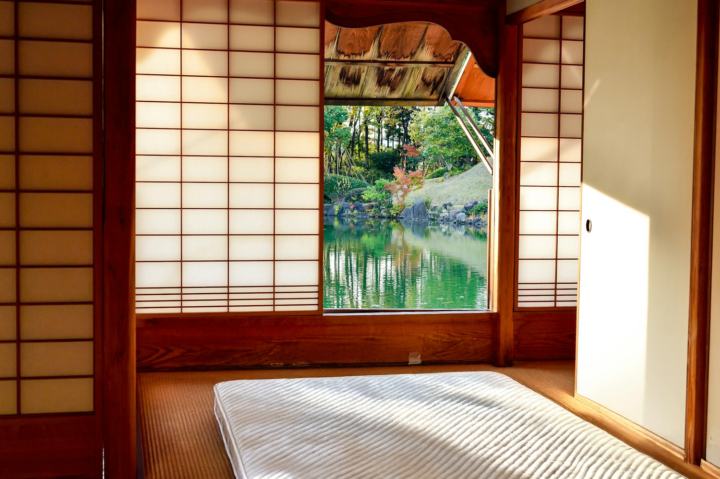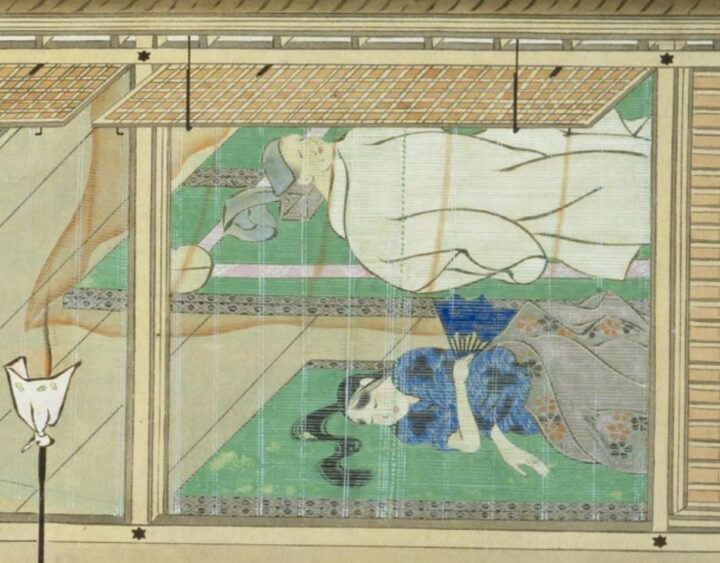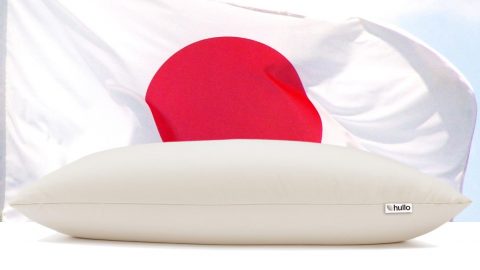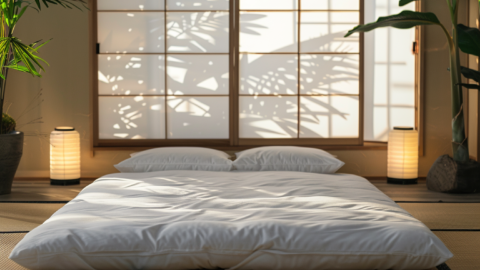
If you’ve ever admired Japanese interior design, you’ve likely encountered a tatami mat. These woven mats have been an integral part of Japanese homes for centuries, offering a blend of functionality, tradition, and cultural significance. But what exactly is a tatami mat, and how does it fit into the traditional Japanese bedding system with shikibuton and futon? Let’s explore!
What Is a Tatami Mat?
A tatami mat is a traditional Japanese flooring material made from natural materials like rice straw and rush grass. It consists of:
- Core: Traditionally filled with compressed rice straw for cushioning, though modern versions may use wood chipboards or polystyrene foam for durability.
- Surface: Covered with woven soft rush grass (igusa) that gives it its iconic appearance and texture.
- Edges: Often bordered with fabric, called heri, which can range from simple to ornate designs.
Tatami mat flooring has been a staple of Japanese architecture for over 1,200 years and is traditionally used in washitsu (Japanese-style rooms). They’re prized for their natural scent, thermal insulation, and slightly springy feel underfoot.
The History of Tatami Mats
Tatami mats date back to the Heian Period (794–1185), when they were considered a luxury item reserved for nobility. During this time, tatami mats were portable and used for sitting or sleeping. By the Muromachi Period (1336–1573), tatami evolved into fixed floor coverings and became more common in samurai households. (Read about sleep history)

Today, tatami mats are still an essential part of Japanese culture, representing simplicity, harmony, and a connection to nature.
How Are Tatami Mats Used?
Tatami mats are versatile and serve multiple purposes in a traditional Japanese home:
1. Flooring: Used as a soft, natural surface for walking, sitting, and sleeping.
2. Zashiki (a Japanese term that refers to a traditional tatami-matted room in a house, inn, or restaurant): People often use rooms with tatami mats for tea ceremonies, meditation, or special gatherings.
3. Bedding Base: a tatami bed mat provides the foundation for the traditional Japanese bedding system, which includes the shikibuton and futon.
Japanese Tatami Mat and Traditional Bedding: Shikibuton vs. Futon
While tatami mats serve as the flooring, they also play a crucial role in traditional Japanese sleeping arrangements. Let’s break it down:
1. Shikibuton
People place a shikibuton, a thin mattress, directly on a tatami mat to create a firm sleeping surface. They roll it up and store it during the day, making it both practical and space-saving. As the base layer for sleeping, the shikibuton pairs perfectly with the firm yet slightly cushioned tatami mat. Manufacturers typically make shikibutons from cotton or wool, which offer natural breathability.
2. Futon
The term futon refers to the entire Japanese bedding system, which includes:
- Shikibuton: The mattress.
- Kakebuton: The duvet or comforter used for warmth.
- Makura: A pillow, often filled with buckwheat hulls.
- Versatility: The futon system is lightweight and compact, allowing you to roll up the components and free up space during the day.
Key Differences
- Shikibuton: Specifically refers to the mattress.
- Futon: Refers to the full bedding set, including the mattress, duvet, and pillow.
Benefits of Tatami Mats
1. Natural Comfort
Tatami mats offer a slightly firm yet springy surface that feels comfortable underfoot and as a base for sleeping.
2. Regulates Humidity
The natural rush grass absorbs and releases moisture.
3. Eco-Friendly
Made from renewable materials, tatami mats are a sustainable choice for those looking to minimize their environmental impact.
4. Space-Saving
When paired with a futon system, tatami mats support a minimalist lifestyle by allowing spaces to serve multiple purposes.
How to Care for Tatami Mats
To keep your tatami mats in great condition, you should follow a few simple care tips. First, vacuum them regularly using a soft brush attachment to gently clean the woven surface without causing damage. Additionally, because tatami mats are sensitive to moisture, it is important to air out the room and ensure proper ventilation to prevent mold or mildew. Finally, avoid wearing shoes on the mats; only barefoot or socked feet should walk on them to preserve their integrity and maintain their appearance.
Tatami Mats in Modern Living
While tatami mats are deeply rooted in tradition, they have also found a place in modern homes worldwide. They are popular for creating calm and natural environments for mindfulness in meditation spaces. Additionally, tatami mats work well in minimalist bedrooms, where they pair seamlessly with a shikibuton for a pared-down sleeping setup. Furthermore, they are ideal for multi-use rooms, as their versatility makes it easy to transition a space from a sleeping area to a workspace or dining area.
The tatami mat is more than just flooring—it’s a symbol of Japanese culture and a testament to the beauty of simplicity and functionality.
Paired with a shikibuton or futon, it offers a unique and healthy sleeping solution that supports mindfulness, sustainability, and minimalist living.
Whether you’re looking to incorporate Japanese aesthetics into your home or improve your sleep quality, tatami mats are a timeless and versatile choice. Ready to bring a piece of tradition into your modern life? Start with a tatami mat!



